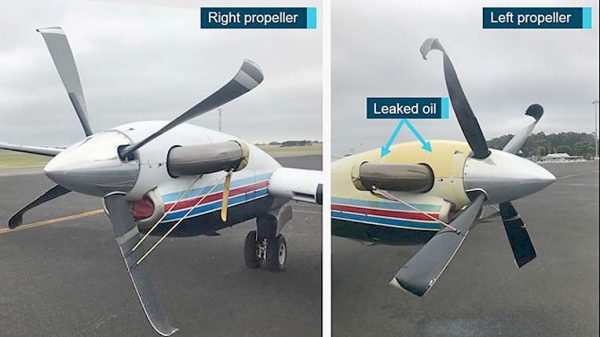

THE propellers of a charter flight with one pilot and seven passengers on board contacted the runway during an attempted landing at Mount Gambier Airport when the aircraft’s landing gear had not extended, a report has found.
On December 8, 2018, a Desert-Air Safaris Beech Aircraft B200 VH-ODI plane originating from Adelaide Airport to Mount Gambier Airport suffered a landing mishap which caused significant damage to both propellers.
The pilot and passengers, one of who was a commercial pilot licence holder seated on the flight deck next to the pilot acting as an observer, were uninjured.
An Australian Transport Safety Bureau investigation into the incident found the aircraft made a hard landing and ground strike, with the propellers contacting the runway twice before the pilot aborted the landing and attempted another approach.
According to the report, the pilot conducted the go-around because he did not have the runway in sight due to cloud at the minimum descent altitude.
Australian Transport Safety Bureau transport safety director Stuart Macleod said after retracting the landing gear, the pilot subsequently sighted the runway and decided to continue the approach, but inadvertently did not re-extend the landing gear.
“As a consequence, the aircraft touched down with the landing gear retracted, with the propellers contacting the runway twice before the pilot initiated a go around,” he said.
During the landing attempt both propellers were damaged, with fragments of the left propeller penetrating the left side of the fuselage.
The left engine also failed upon the application of power for the go-around, but the aircraft ultimately landed without further incident.
“The pilot’s expectation of the landing gear position, possibly coupled with the effects of the now increased workload, probably led to him not detecting the retracted landing gear before the aircraft contacted the runway,” Mr Macleod said.
The safety bureau’s investigation noted the decision to conduct a go-around resulted from the pilot’s misunderstanding of the situation and assessment that a runway overrun was imminent.
“There are hazards associated with spontaneous decision-making, particularly during a high workload phase of flight in a complex aircraft,” Mr Macleod said.
“Research on unexpected changes in workload during flight has found that pilots who encounter abnormal or emergency situations experience a higher workload with an increase in the number of errors compared to pilots not experiencing these situations.”
Mr Macleod noted the pilot and his youngest son sadly lost their lives in a bushfire on Kangaroo Island in January this year.
“The Australian Transport Safety Bureau acknowledges the contribution the pilot made to the aviation and outback tourism industries and thanks his family for their cooperation during the final stages of this investigation during a very difficult time,” he said.







